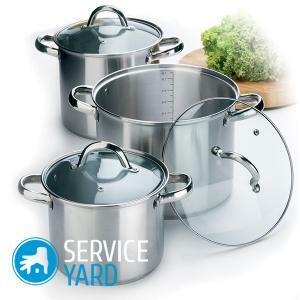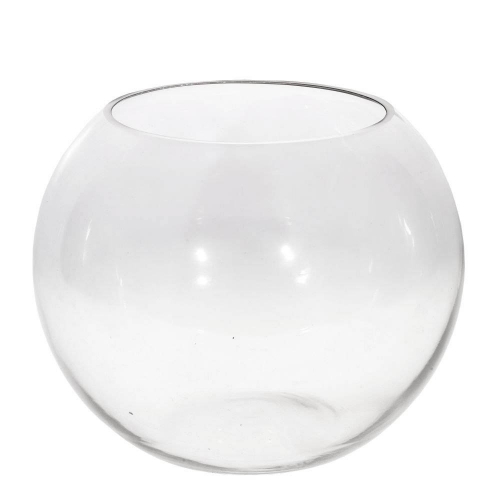
- Features of the alloy and production technology
- What is the encapsulated bottom?
- Advantages of stainless steel cookware:
- How to choose the right stainless steel utensils
- Cookware sets for the kitchen
- Care for the dishes
Just recently the choice of kitchen utensils was not great. On the shelves mostly stood enamelled, aluminum or cast-iron dishes. The stainless steel saucepan has gained special popularity already in the 21st century thanks to its advantages and useful properties. And today stainless steel cookware is in great demand among professional chefs and housewives. In this article we will tell about all the advantages and disadvantages of stainless steel cookware, familiarize with the rules of care for such kitchen utensils and advise how to choose quality products for cooking.
to Contents ↑Features of the alloy and production technology
Stainless steel is an alloy of nickel and chromium with iron. In the manufacture of stainless steel utensils, steel grade 18/10 is used, where the numbers indicate the percentage composition of chromium and nickel.
Important! In addition to the indicated components, the composition of the alloy includes iron, 0.12% carbon and 1% of various impurities.
Alloys from steel were developed much earlier and were used in the food industry mainly for the production of cutlery. But pots made from such an alloy have only recently been used. This is due to the physical property of steel - such as low thermal conductivity, due to which the metal slowly and unevenly warms up. The invention of the encapsulated bottom radically changed the situation. Initially, the technology of the encapsulated bottom was used for frying pans, and then this method was used to make all the dishes made of steel. Thus, and there were pots made of stainless steel.
to the contents ↑What is the encapsulated bottom?
The encapsulated bottom is also called "double".However, the expression "double bottom" is not a true saying, since in fact it is a three-layered fragment of steel dishes. Between the two strata of stainless steel is placed a copper or aluminum disk, which is perfectly heated and distributes heat.
Aluminum itself is not suitable for making bottoms, as it quickly burns, spoils and stains the slab. However, together with the steel capsule covering the bottom, it was possible to combine the advantages of these two materials: the heat-resistant properties of stainless steel and the heat-distributing function of aluminum. It is this bottom that is called encapsulated.
The cost of aluminum is lower than the cost of copper, therefore, steelware with aluminum is a more economical option, and such utensils are in no way inferior to objects with a copper disk. According to the standards of GOST:
- The thickness of the aluminum layer should be at least 3 mm, otherwise - the food will burn.
- The thickness of copper can be from 1.5 mm, since this material has a higher thermal conductivity.
Important! The ideal option is stainless steel cookware with a 5 mm layer of aluminum. A thicker layer will cause the dishes to warm up for a long time.
 There is also a encapsulated bottom with walls, but this option does not allow using a disc thickness exceeding 2 mm, which means it will not give a good result when cooking.
There is also a encapsulated bottom with walls, but this option does not allow using a disc thickness exceeding 2 mm, which means it will not give a good result when cooking.
Advantages of the encapsulated bottom:
- Prevents food burning.
- Allows you to cook without the use of fats and oils.
- Saves the maximum number of useful properties of cooked products.
- Saves energy, thanks to the quality of thermal storage( heat accumulation).The saucepan can always be turned off before the end of cooking.
Advantages of stainless steel cookware:
- Hygiene. The surface of the utensils is perfectly smooth. This advantage helps to prevent the accumulation of harmful substances and microbes in the cracks and scratches of the dishes.
- Dishes made of steel are not afraid of alkali and acid. When using such products, there is no adverse effect on the taste of food.
- Functionality. Due to the fact that the material does not oxidize, all kinds of food can be cooked in stainless steel bowls - borsch, rassolniki, marinades, fruit and berry dishes. In addition, in such pots you can store cooked food for a long time.
- Stainless steel cookware can be used on any cooker - gas, electric, induction and cermet. Do not use in microwave oven only.
- Durability. Dishes made of steel with proper care will serve more than one generation.
- Strength. Thanks to this advantage, the dishes are not subject to deformation and do not collapse. Such dishes do not beat or scratch.
- Food in such utensils does not burn, thanks to a thick bottom, which allows cooking dishes without using excess fats.
- Do not corrode.
- Beautiful appearance, lasting for years.
- The dish is easy to clean and clean thanks to a smooth surface.
How to choose the right stainless steel utensils
In order to choose high-quality stainless steel utensils, it is necessary to pay attention to the following characteristics.
Method of manufacturing
By the way of production, stainless steel saucepans are divided into:
- Solid-cast. Are made with application of technology of soldering. The cost of this type of pot is higher, but the service life is longer.
- Stamped. Produce such dishes by pressing. This dish is sold much better, mainly because of the low price.
Steel grade
The first place in quality is steel with chromium and nickel( No. 304).At the moment there is no material that would surpass this steel grade for its useful properties. Most types of dishes are made from it. The so-called medical steel does not darken during operation, it is resistant to various mechanical damages.
Important! To find just the quality material, pay attention to the bottom of the pan. If you find the marking 18/10, then it means that you have the best quality pan in your hands.
The material of the disk between the
stainless steel This factor will affect the cost of the dishes - if the disk is made of copper, the model of the utensils will cost more than the similar one with an aluminum disc, but on the quality of the dishes, this does not affect.
Thickness of
walls The minimum thickness, according to GOST standards, is 0.5 mm. Ideal option will be a model with a wall thickness of 0.8 mm. Pans with a wall thickness of 1 mm will be heated longer and their weight is much greater.
Surface of steel tableware
Steel pans with a matte surface cool faster, so they are mainly used in the restaurant business. Housewives prefer pans with a polished surface, since such models better keep the heat.
Important! According to the GOST standards, the surface of stainless utensils should not have any damage or deformation. By the same standards only 3 point errors are allowed, as well as for enamelware.
Paddle handles
Pans with removable handles have a higher price, in addition, the price of the product is affected by the material of the handle. On sale there are pots with metal, wooden and plastic handles.
Important! Metal handles on a quality product are not heated during cooking, but plastic can melt and produce a rather unpleasant smell if the hostess does not follow the intensity of the fire.
Country of production and brand
Until recently, quality dishes were considered European manufacturers, especially Belgian and German companies( Rondell, Krauff, Fissler).However, domestic utensils are in no way inferior in quality, but the price of such utensils may be an order of magnitude lower.
Important! When buying a product, be sure to read the certificate. And remember that the stainless steel dishes are given a guarantee, usually 2 years.
Additional tips:
- When choosing a pan, pay attention to one more detail - the tightness of the lid. Not bad if the lid is glass or transparent to control the cooking process.
- Do not pay much attention to such useless bells and whistles as the temperature sensor on the lids of the dishes or copper inserts in the center of the cover layer of the encapsulated bottom. All these "chips" are absolutely useless.
Sets of saucepans for the kitchen
Usually it is not enough for the hostess to buy one pan to satisfy the need for cooking. Therefore, manufacturers produce whole sets of pots to simplify the choice - containers of different volume and size for cooking different dishes. To buy such a set is cheaper, than to choose pots separately.
Important! In the forefront of this production are German sets of Rondell saucepans, sets of kitchen utensils luminarc, and the Belgian company berghoff.
If you are tired of gray color, then choose colored pots or a variant with color accessories( potholders, handles or lid holder), which are now produced in a huge assortment by manufacturers. Such a wide choice allows you to choose all the kitchen utensils for the style of any kitchen.
to the table of contents ↑Care of the dishes
To keep the beauty and functionality of the stainless steel dishes for a long time, properly look after it:
- Do not put the pan on the fire immediately after purchase. First, wash it thoroughly and wipe it dry with a soft rag. If you completely wipe the moisture after washing dishes, then for a long time, keep its shiny surface.
- Do not store food for too long after cooking. Sour food and salt will spoil the beautiful surface of the utensils.
- For cooking, use special spatulas that do not scratch the surface of the pan.
- Try not to use the dishwasher to clean such a material. Use the dishwasher only if it is stipulated in the instructions or hygienic certificate for the goods.
- Do not place an empty saucepan on a fire to avoid iridescent stains. If they suddenly appeared, then citric acid or vinegar will help cope with them.
- Add salt only to boiling liquid, otherwise - on the walls of the dishes can remain white salt spots.
- Do not fill the dishes with cold water for rapid cooling. The poultry should be cooled by itself.
- Stainless steel pans are washed with ordinary dishwashing liquid( s).It is strictly forbidden to clean the surface of stainless utensils with abrasive agents.
- Do not use chlorinated and ammonia cleaning agents to clean the dishes.
- For washing dishes, use a soft sponge that will not scratch the inner and outer walls of the pan.
- If food accidentally burns, pour the saucepan with warm water and add salt. Leave the dishes for 1.5-2 hours, and then wash it. You can use a soapy solution to remove the remnants of food - pour the solution into a saucepan and boil it for 5-10 minutes.
- To restore the shine of a stainless steel saucepan, rinse it with hot potato broth and wipe dry.
As kitchenware is not bought so often, then refer to the choice of a stainless steel saucepan responsibly. When buying, carefully examine the quality certificate to see if this is really durable and quality. The French say: "Good dishes are the guarantee of a good dinner," we suggest that you be convinced of this.



